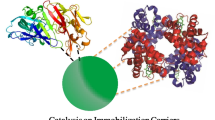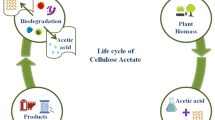Abstract
Cellulase from Trichoderma reesei (Celluclast 1.5 L, Novozyme) was immobilized by sol–gel encapsulation, using binary or ternary mixtures of tetramethoxysilane (TMOS) with alkyl- or aryl-substituted trimethoxysilanes as precursors. Optimization of immobilization conditions resulted in 92 % recovery of total enzymatic activity in the best immobilized preparate. The immobilized cellulase exhibiting the highest activity, obtained from tetramethoxysilane and methyltrimethoxysilane precursors at 3:1 molar ratio, was investigated in the hydrolysis reaction of microcrystalline cellulose (Avicel PH101). Although the optimal values did not change significantly, both temperature and pH stabilities of the sol–gel entrapped cellulase improved compared to the native enzyme. Immobilization also conferred superior resistance against the inactivation effect of glucose. Reuse of the sol–gel entrapped cellulase showed 40 % retention of the initial activity after five batch hydrolysis cycles, demonstrating the potential of this biocatalyst for large-scale application.









Similar content being viewed by others
References
Nigan PS, Singh A (2011) Production of liquid biofuels from renewable resources. Prog Energy Combust 37:52–68
Mabee WE, Saddler JN (2010) Bioethanol from lignocellulosics: status and perspectives in Canada. Bioresour Technol 101:4806–4813
Scott EL, Kootstra AMJ, Sanders JPM (2010) In: Singh OM, Harvey SP (eds) Sustainable biotechnology. Sources of renewable energy. Springer, Dordrecht
Naik SN, Goud VV, Rout PK, Dalai AK (2010) Production of first and second generation biofuels: a comprehensive review. Renew Sustain Energy Rev 14:578–597
Jordan J, Kumar CSSR, Theegala C (2011) Preparation and characterization of cellulase-bound magnetite nanoparticles. J Mol Cat B: Enzymatic 68:139–146
Dincer A, Telefoncu A (2007) Improving the stability of cellulase by immobilization on modified polyvinyl alcohol coated chitosan beads. J Mol Cat B: Enzymatic 45:10–14
Jones PO, Vasudevan PT (2010) Cellulose hydrolysis by immobilized Trichoderma reesei cellulose. Biotechnol Lett 32:103–106
Kharrat N, BenAli Y, Marzouk S, Gargouri Y, Karra-Châabouni M (2011) Immobilization of Rhizopus oryzae lipase on silica aerogels by adsorption: comparison with the free enzyme. Process Biochem 46:1083–1089
Pazarlioğlu NK, Sariişik M, Telefoncu A (2005) Treating denim fabrics with immobilized commercial cellulases. Process Biochem 40:767–771
Sinegani AAS, Emtiazi G, Shariatmadari H (2005) Sorption and immobilization of cellulase on silicate clay minerals. J Coll Interface Sci 290:39–44
Lozano P, Bernal B, Bernal JM, Pucheault M, Vaultier M (2011) Stabilizing immobilized cellulase by ionic liquids for saccharification of cellulose solutions in 1-butyl-3-methylimidazolium chloride. Green Chem 13:1406–1410
Hartono SB, Qiao SZ, Liu J, Jack K, Ladewig BP, Hao Z, Lu GQM (2010) Functionalized mesoporous silica with very large pores for cellulase immobilization. J Phys Chem 114:8353–8362
Lupoi JS, Smith EA (2011) Evaluation of nanoparticle-stabilized cellulase for improved ethanol yield in simultaneous saccharification and fermentation reactions. Biotechnol Bioeng 108:2835–2843
Takimoto A, Shiomi T, Ino K, Tsunoda T, Kawai A, Mizukami F, Sakaguchi K (2008) Encapsulation of cellulase with mesoporous silica (SBA-15). Micropor Mesopor Mat 116:601–606
Darias R, Villalonga R (2001) Functional stabilization of cellulase by covalent modification with chitosan. J Chem Technol Biotechnol 76:489–493
Xu J, Huo S, Yuan Z, Zhang Y, Xu H (2011) Characterization of direct cellulase immobilization with superparamagnetic nanoparticles. Biocat Biotransform 29:71–76
Chang RH-Y, Jang J, Wu KC-W (2011) Cellulase immobilized mesoporous silica nanocrystals for efficient cellulose-to-glucose conversion. Green Chem 13:2844–2850
Abd El-Ghaffar MA, Hashem MS (2010) Chitosan and its amino acids condensation adducts as reactive natural polymer supports for cellulase immobilization. Carbohydr Polym 81:507–516
Mao X, Guo G, Huang J, Du Z, Huang Z, Ma L, Li P, Gu L (2006) A novel method to prepare chitosan powder and its application in cellulase immobilization. J Chem Technol Biotechnol 81:89–195
Feng T, Du Y, Yang J, Li J, Shi X (2006) Immobilization of a nonspecific chitosan hydrolytic enzyme for application in preparation of water-soluble low-molecular-weight chitosan. J Appl Polym Sci 101:1334–1339
Lee S-M, Jin LH, Kim JH, Han SO, Na HB, Hyeon T, Koo Y-M, Kim J, Lee J-H (2010) β-Glucosidase coating on polymer nanofibers for improved cellulosic ethanol production. Bioprocess Biosyst Eng 33:141–147
Kourkoutas Y, Bekatorou A, Banat IM, Marchant R, Koutinas AA (2004) Immobilization technologies and support materials suitable in alcohol beverages production: a review. Food Microbiol 21:377–397
Pierre AC (2004) The sol-gel encapsulation of enzymes. Biocatal Biotransform 22:145–170
Vidinha P, Augusto V, Almeida M, Fonseca I, Fidalgo A, Ilharco L, Cabral JMS, Barreiros S (2006) Sol–gel encapsulation: an efficient and versatile immobilization technique for cutinase in non-aqueous media. J Biotechnol 121:23–33
Zarcula C, Kiss C, Corîci L, Croitoru R, Csunderlik C, Peter F (2009) Combined sol-gel entrapment and adsorption method to obtain solid-phase lipase biocatalyst. Rev Chim (Bucharest) 60(9):922–927
Tomin A, Weiser D, Hellner G, Bata Z, Corici L, Peter F, Koczka B, Poppe L (2011) Fine-tuning the second generation sol–gel lipase immobilization with ternary alkoxysilane precursor systems. Process Biochem 46:52–58
Das S, Berke-Schlessel D, Ji H-F, McDonough J, Wei Y (2011) Enzymatic hydrolysis of biomass with recyclable use of cellobiase enzyme immobilized in sol-gel routed mesoporous silica. J Mol Cat B: Enzymatic 70:49–54
Paljevac M, Primožič M, Habulin M, Novak Z, Knez Z (2007) Hydrolysis of carboxymethyl cellulose catalyzed by cellulase immobilized on silica gels at low and high pressures. J Supercrit Fluids 43:74–80
Andriani D, Sunwoo C, Ryu H-W, Prasetya B, Park D-H (2012) Immobilization of cellulase from newly isolated strain Bacillus subtilis TD6 using calcium alginate as a support material. Bioprocess Biosyst Eng 35:29–33
Zarcula C, Corici L, Croitoru R, Ursoiu A, Peter F (2010) Preparation and properties of xerogels obtained by ionic liquid incorporation during the immobilization of lipase by the sol–gel method. J Mol Cat B: Enzymatic 65:79–86
Kawakami K, Yoshida S (1996) Thermal stabilization of lipase by sol–gel entrapment in organically modified silicates formed on kieselguhr. J Ferment Bioeng 82:239–245
Lowry OH, Rosebrough NJ, Farr AL, Randall RL (1951) Protein measurement with the Folin phenol reagent. J Biol Chem 193:265–275
Ghose TK (1987) Measurements of cellulase activities. Pure Appl Chem 2:257–268
Miller GL (1972) Use of dinitrosalicylic acid reagent determination of reducing sugar. Anal Chem 31:426–428
Berghem LER, Petterson LG, Axiö-Fredriksson U-B (1975) Characterization and enzymatic properties of a β-1,4-glucan cellobiohydrolase from Trichoderma viride. Eur J Biochem 53:55–62
Corici LN, Frissen AE, van Zoelen D-J, Eggen IF, Peter F, Davidescu CM, Boeriu CG (2011) Sol-gel immobilization of Alcalase from Bacillus licheniformis for application in the synthesis of C-terminal peptide amides. J Mol Cat B: Enzymatic 73:90–97
Turner MB, Spear SK, Huddleston JG, Holbrey JD, Rogers RD (2003) Ionic liquid salt-induced inactivation and unfolding of cellulase from Trichoderma reesei. Green Chem 5:443–447
Zandoná Filho A, Siika-Aho M, Ramos LP (2006) Method for characterization of the enzyme profile and the determination of CBH I (Cel 7a) core protein in Trichoderma reesei cellulase preparations. World J Microbiol Biotechnol 22:821–825
Bansal P, Hall M, Reallf MJ, Lee JH, Bommarius AS (2009) Modeling cellulase kinetics on lignocellulosic substrates. Biotechnol Adv 27:833–848
Andrić P, Meyer SA, Jensen PA, Dam-Johansen K (2010) Effect of modeling of glucose inhibition and in situ glucose removal during enzymatic hydrolysis of pretreated wheat straw. Appl Biochem Biotechnol 160:280–297
Bélafi-Bakó K, Koutinas A, Nemestóthy N, Gubicza L, Webb C (2006) Continuous enzymatic cellulose hydrolysis in a tubular membrane bioreactor. Enzyme Microb Technol 38:155–161
Chang K, Thitikorn-amorn J, Chen S, Hsieh J, Ratanakhanokchai K, Huang P, Lin T, Chen S (2011) Improving the remaining activity of lignocellulolytic enzymes by membrane entrapment. Bioresour Technol 102:519–523
Balsan G, Astolfi V, Benazzi T, Meireles MAA, Maugeri F, Di Luccio M, Dal Prá V, Mossi AJ, Treichel H, Mazutti MA (2012) Characterization of a commercial cellulase for hydrolysis of agroindustrial substrates. Bioprocess Biosyst Eng 35:1229–1237
Bezerra RMF, Dias AA (2004) Discrimination among eight modified Michaelis-Menten kinetic models of cellulose hydrolysis with a large range of substrate/enzyme ratios. Appl Biochem Biotechnol 112:173–184
Yu Y, Yuan J, Wang Q, Fan X, Wang P (2012) Covalent immobilization of cellulases onto a water-soluble-insoluble reversible polymer. Appl Biochem Biotechnol 166:1433–1441
Li C, Yoshimoto M, Fukunaga K, Nakao K (2007) Characterization and immobilization of liposome-bound cellulase for hydrolysis of insoluble cellulose. Bioresour Technol 98:1366–1372
Acknowledgments
This work was partially supported by the strategic grants POSDRU 2009, project ID 50783, of the Ministry of Labour, Family and Social Protection, and by the grant POSDRU/21/1.5/G/13798, inside POSDRU Romania 2007–2013, co-financed by the European Social Fund—Investing in People. Financial support of this work was provided by UEFISCDI through PNII-Parteneriate grant No. 21077, 2007–2010.
Author information
Authors and Affiliations
Corresponding author
Rights and permissions
About this article
Cite this article
Ungurean, M., Paul, C. & Peter, F. Cellulase immobilized by sol–gel entrapment for efficient hydrolysis of cellulose. Bioprocess Biosyst Eng 36, 1327–1338 (2013). https://doi.org/10.1007/s00449-012-0835-9
Received:
Published:
Issue Date:
DOI: https://doi.org/10.1007/s00449-012-0835-9




